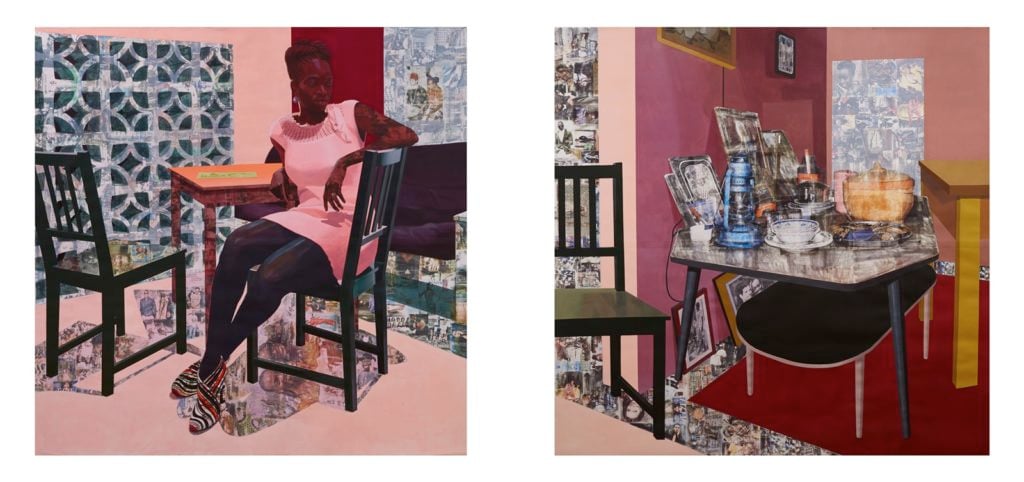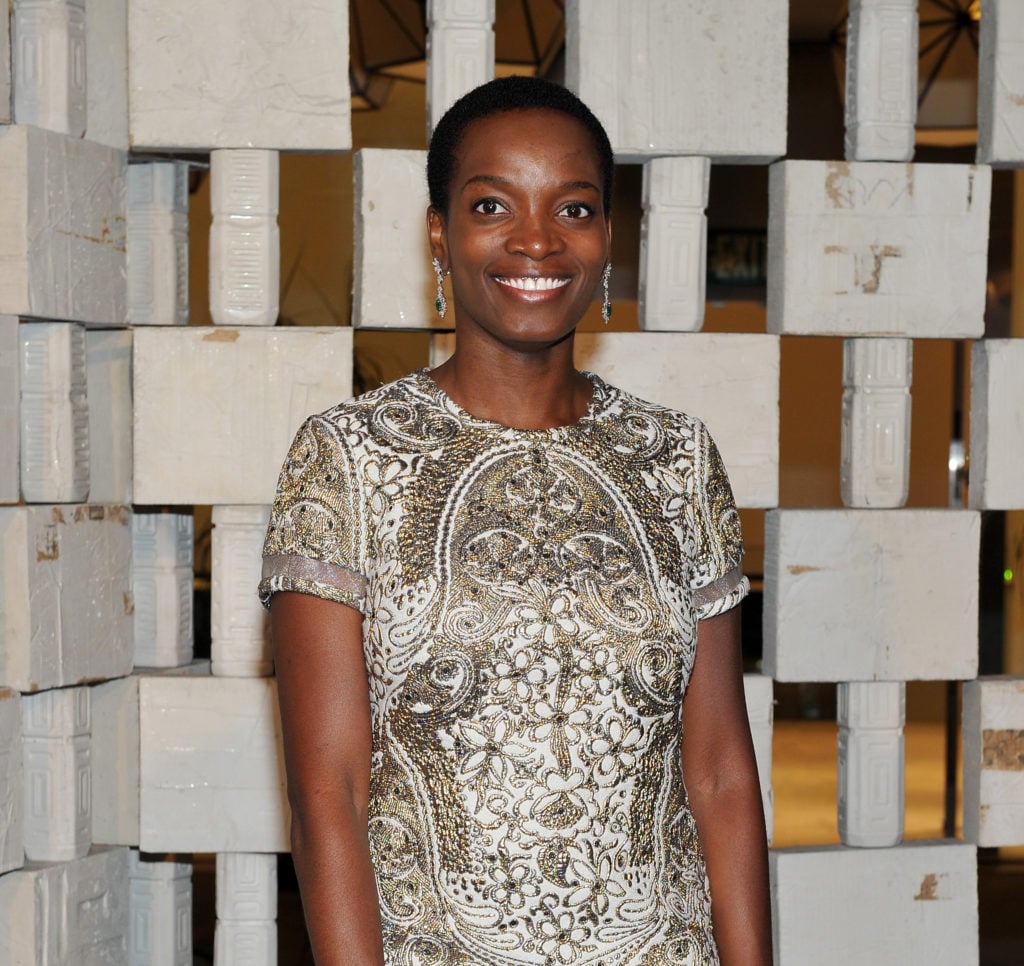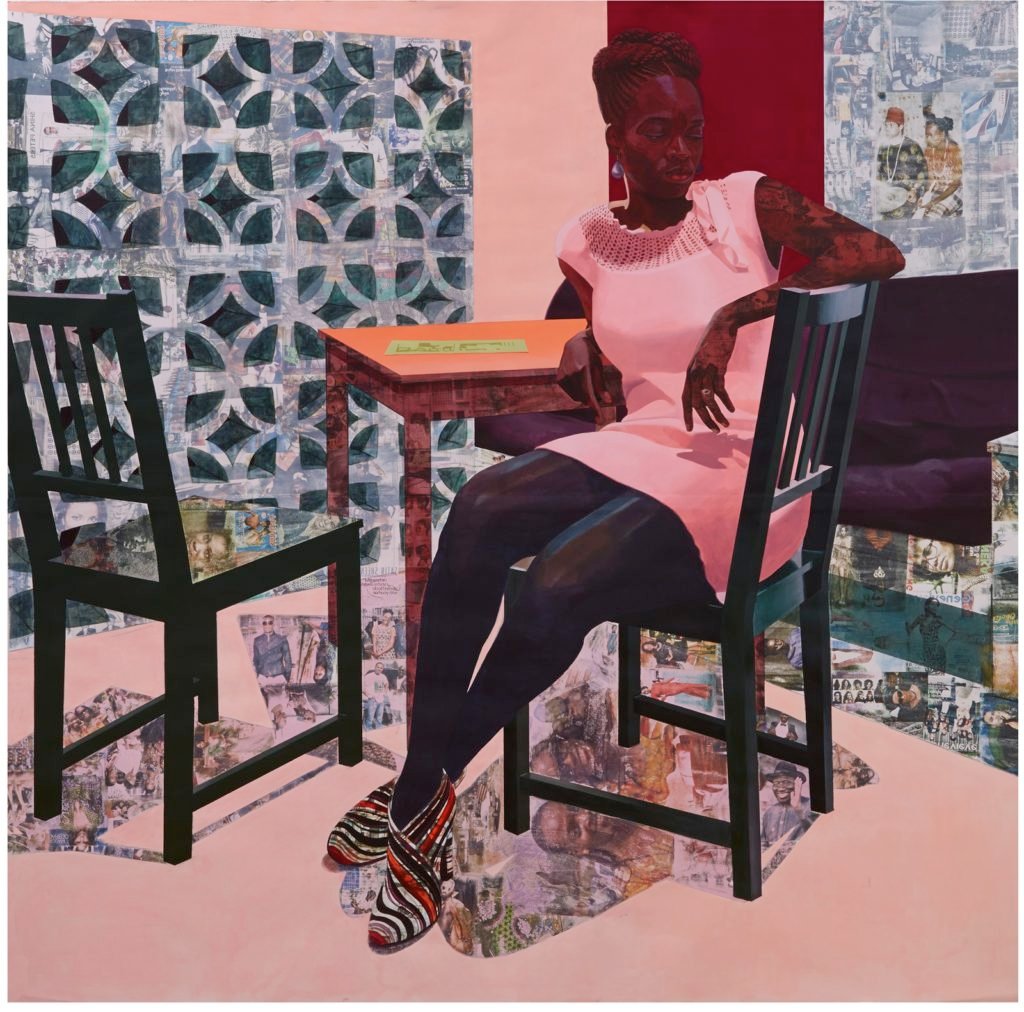Art World
‘I Can Spend Three Full Days Online’: Njideka Akunyili Crosby on the Photo-Collage Paintings That Made Her a MacArthur ‘Genius’
A chance encounter with cadmium red spurred this masterful diptych.

A chance encounter with cadmium red spurred this masterful diptych.

Brian Boucher

Already on a dramatic career rise in the six years since Njideka Akunyili Crosby earned her MFA from Yale, the Nigerian-American painter shot into the cultural stratosphere on Tuesday when she was named a 2017 MacArthur fellow. Her contemplative paintings are also the subject of two new solo museum exhibitions, at the Baltimore Museum of Art and the Frances Young Tang Teaching Museum and Art Gallery at Skidmore College, in Saratoga Springs, New York.
Akunyili Crosby’s paintings of herself, her family, and friends, often relaxing or embracing in their homes and other private spaces, explore cultural hybridity through a welter of references. They contain images of popular Nigerian musicians and beauty queens, ads from fashion magazines, and photographs from family events to situate themes relating to tradition and newness, politics and culture, and urban and rural in buzzing tension. African viewers may be able to immediately decode the images, while they may require some elucidation for the average Western observer.

Artist Njideka Akunyili Crosby. (Photo by Donato Sardella/Getty Images for Hammer Museum)
Born in Enugu, Nigeria, in 1983, Akunyili Crosby came to the US to study at Swarthmore College, where she earned degrees in biology and studio art. She has since staged a 2015–16 exhibition at Los Angeles’s Hammer Museum and appeared in the current Istanbul Biennial, Prospect New Orleans, and a group shows at New York’s Metropolitan Museum of Art. She has also become a breakout star at auction: Last fall, her painting Drown (2012) rocketed past its $25,000 high estimate to fetch $93,750 at Sotheby’s New York. Today she lives in Los Angeles and is represented by London’s Victoria Miro Gallery.
For this edition of “Origin Story,” a series that explores the backstories behind individual works of art, the artist spoke with artnet News by phone about the inspiration for her diptych Predecessors, which is on view at the Tang.

Njideka Akunyili Crosby, Predecessors, detail (2013). Courtesy of the artist and Tate.
To start with formal questions, what led to the decisions to make this painting a diptych and to use such a distinctive palette for it?
In some ways the inspiration here was more about form than content. Visiting the Philadelphia Museum of Art, I saw a small Degas painting [After the Bath (Woman Drying Herself), c. 1896]. Its rich red palette, with lots of cadmium, was highly controlled, and I remember having that moment when you see something you want to use. This would be a challenge to myself: a painting dominated by one color. His was a very warm red, whereas I decided to use a cool pigment called quinacridone red.
And how did the painting come to be a diptych?
I wanted to paint an interior with no one in it. Up to that point, in paintings where the figure was very dominant, I wasn’t paying as much attention to the space. Here, I wanted to bring as much rigor to the space as to the figure. I was a little bit scared, so doing it as a diptych was a way to give myself courage: What if one panel had the figure and one did not, so I didn’t feel like I was diving into the deep end?
The found photographs, transferred onto the canvas, are common in your work, and prevalent throughout both panels here. What are the sources for those images?
They come from magazine ads, fashion and lifestyle pictures. Every time I go back to Nigeria I buy pictures from the photographer who shoots our family’s events—even if he thinks they’re not good. Or from friends’ Facebook pages, or family albums and popular album covers. Plus, I can spend three full days online trying to find one particular image, before the moment when I say, “Ha! I know this!” I look for those that showcase a hybrid space, and not just Nigeria—there are many such spaces, most obviously formerly colonized places.
In the case of Nigeria specifically, what does that hybrid space mean to you? How do you capture that visually?
It’s partly to do with a question: What is tradition? In Nigeria, more than 200 tribes have been lumped together. The cultures from the various tribes merge; there’s inter-tribal appropriation and borrowing. On top of that, someone can wear a “traditional” wedding outfit, including a top hat, which comes from when Nigeria was a British colony, but now is part of the tradition of the Niger Delta, like lawyers wearing white wigs. The British people leave various traditions behind, and they don’t just stay put. They gradually morph and the Nigerians adapt them to say what they want. Then, starting in the late 1970s, the markers of cultural capital move from the United Kingdom to the United States. These things have been interwoven into an evolving space that is Nigeria.
If there’s a very famous writer, say Chinua Achebe, who’s of my parents’ generation, then I had to think of a writer from my generation for the other panel, which turned out to be Chimamanda Ngozi Adichie. If there’s a musician who was really big in the ’80s, say Prince Nico Mbarga, who had the biggest Afro Highlife hit on the continent with “Sweet Mother,” then there’s 2face Idibia, who had the biggest hit several years ago with “African Queen.”

Njideka Akunyili Crosby, Predecessors, detail (2013). Courtesy of the artist and Tate.
Your family is a key subject of yours. How does that play out in Predecessors?
I wanted to make a work about generations, so I went to the village where I used to spend summers with my grandmother. The tabletop with her photos [in the right-hand panel] was still as it was when she was alive. She was from the generation that never left the village and didn’t speak English. My parents straddled the village and the city, dreaming about a cosmopolitan life, then my generation straddled Nigeria and somewhere else—so then there’s me with the Ikea futon and chairs, which are clearly my post-college apartment in the United States. The diptych becomes a very direct analogue of straddling cultures.
“Front Room: Njideka Akunyili Crosby | Counterparts” will be at the Baltimore Museum of Art, October 25, 2017–March 18, 2018. “Opener 30: Njideka Akunyili Crosby: Predecessors” is open at the Frances Young Tang Teaching Museum and Art Gallery, Saratoga Springs, New York, through December 31, 2017.
“Origin Story” is a column in which we examine the backstory of an individual work of art.